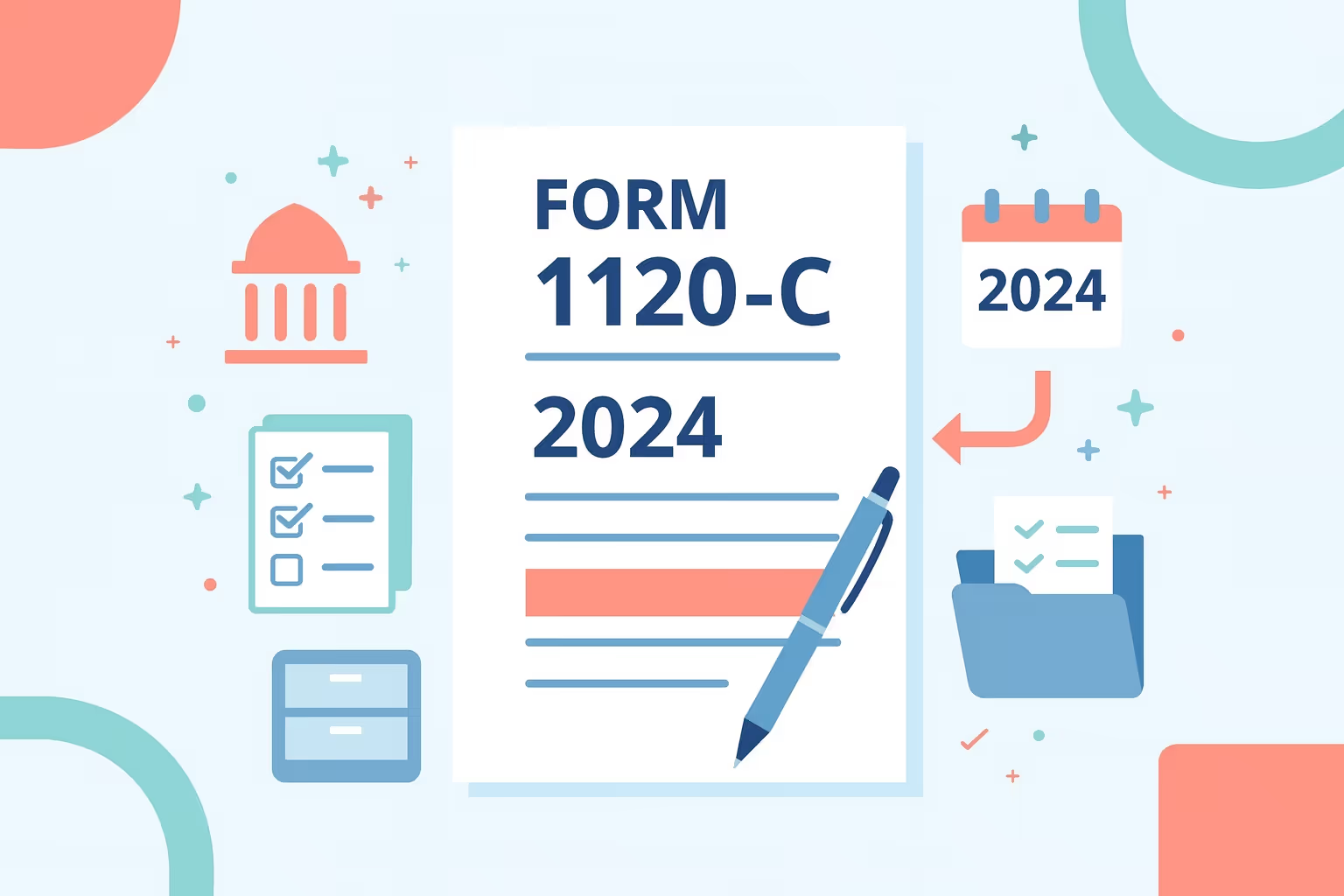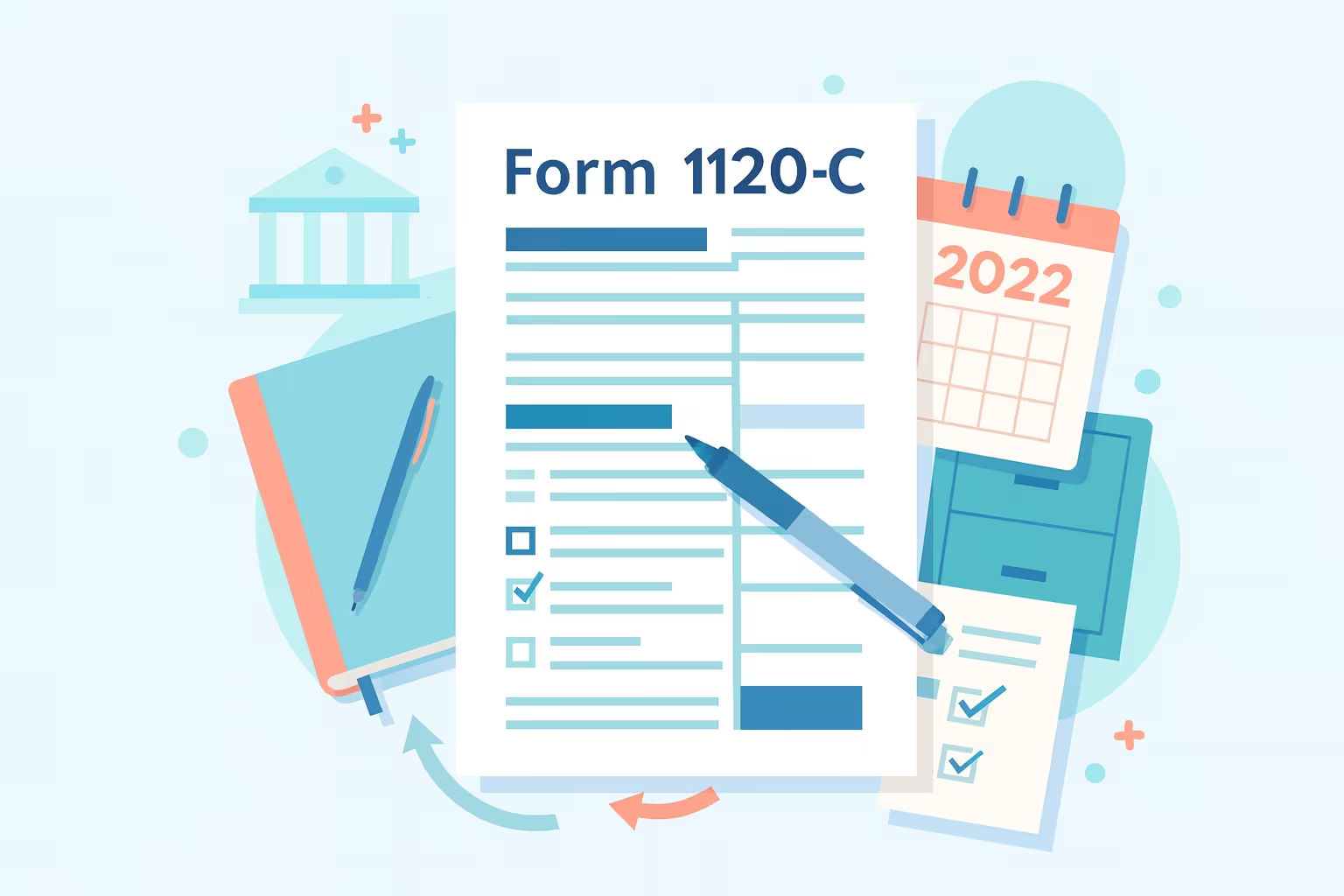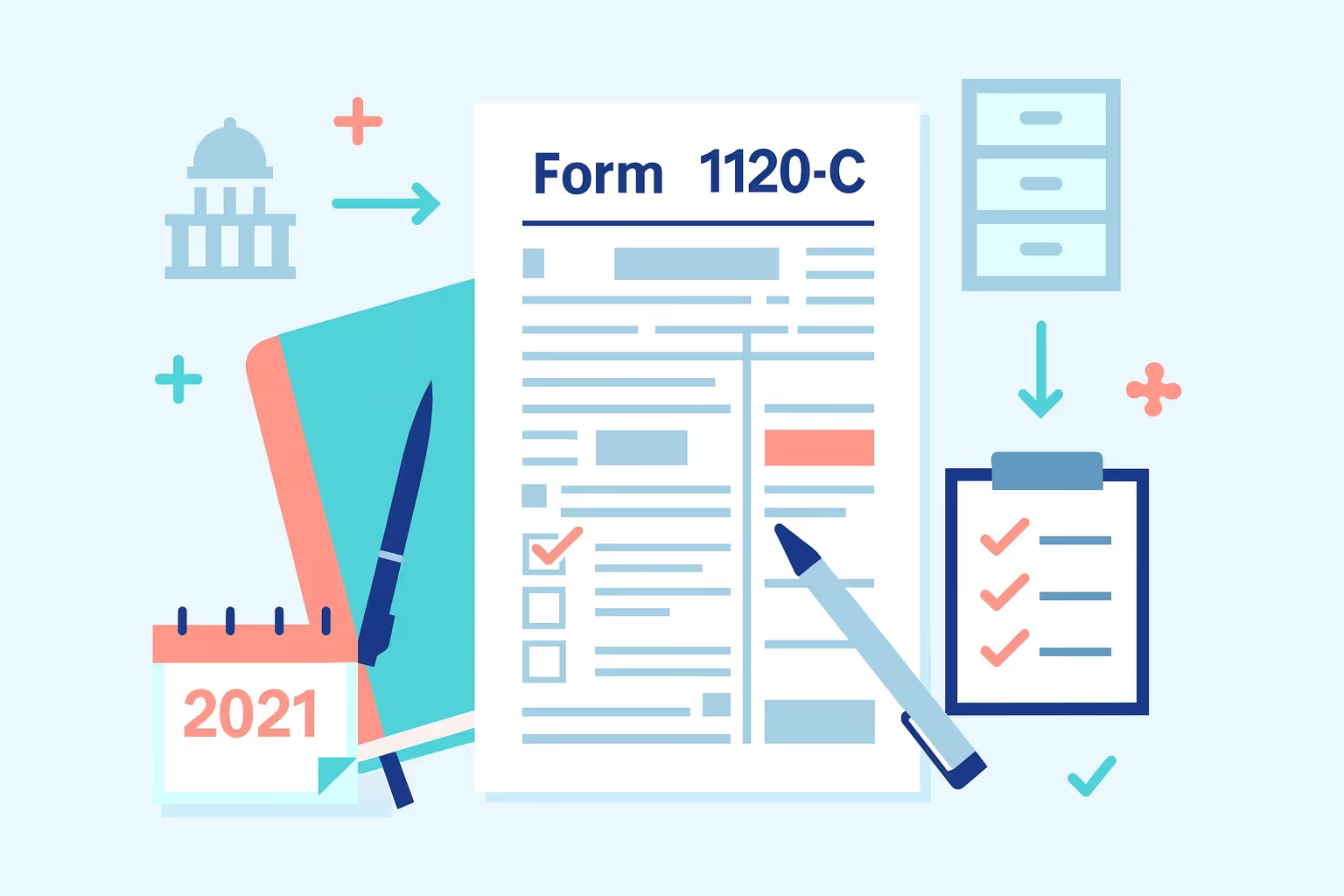How to File Federal Form 1120-C for Tax Year 2023

Cooperatives filing their federal tax returns face a decision that can have serious financial consequences: how and when to file. The IRS reports that paper filers can wait eight weeks or longer for refunds, while electronic filers often receive theirs in three weeks. In an economy where every dollar counts, waiting months for money owed to your cooperative can pressure operations and shake member confidence.
Federal Form 1120-C for tax year 2023 is the income tax return designed explicitly for cooperative associations. It determines federal income tax liability, reports gross receipts, and documents patronage dividends and other income. Filing it correctly protects against penalties, ensures compliance with tax laws, and gives your cooperative faster access to refunds that can be reinvested into services, member programs, or reserves. Errors, missed deductions, or delays do not just create frustration; they directly impact financial stability.
This guide will walk you through every step of filing Form 1120-C. We will highlight the most important changes for 2023, outline filing requirements, explain how to report income and deductions, and show you how to avoid the common mistakes that lead to costly delays. Whether you are filing for the first time or managing complex allocations, this roadmap will give your cooperative clarity, accuracy, and peace of mind.
Federal Form 1120-C: What it is and Why it Matters
Before you can file correctly, it is essential to understand the role of Federal Form 1120-C for tax year 2023 and why it is central to cooperative operations. This form is not just another tax return but a specialized income tax return created specifically for cooperative associations.
Purpose and scope
- Federal Form 1120-C for tax year 2023 is designed to report income, gains, losses, deductions, and credits for cooperatives. It calculates federal income tax liability and accurately discloses patronage dividends, per-unit retain allocations, and other financial information. This keeps reporting consistent with Internal Revenue Service rules and the Internal Revenue Code.
- The form also complies with the requirement that cooperatives allocate income correctly between patronage and nonpatronage sources. Supporting schedules and special deductions ensure that taxable income reflects cooperative principles and legal requirements.
Who typically files
- Cooperative associations are the primary filers. This includes farmers' tax-exempt cooperative groups, marketing, utility, and supply cooperatives. Domestic corporations operating cooperatively must use this form, while foreign corporations may be subject to different filing requirements. A tax professional should be consulted if cross-border transactions are involved.
- Certain entities, like homeowners' associations, usually file different tax returns, but in rare cases, they may be classified as C corporations. For this reason, reviewing filing requirements carefully prevents costly misfilings.
Filing Requirements for Federal Form 1120-C (2023)
Understanding who must file and when is one of the most essential parts of compliance. Filing requirements can apply even when a cooperative shows no taxable income. The Internal Revenue Service enforces strict deadlines, and missed dates lead to automatic penalties that can drain resources.
Entities and thresholds
- Any corporation operating on a cooperative basis that allocates patronage dividends must file Form 1120-C for the tax year 2023. This applies even if the cooperative has no net income to report. Farmers' tax-exempt cooperative associations, marketing groups, supply cooperatives, and credit unions operating as cooperatives all fall into this category.
- Filing requirements are also influenced by financial size. If your cooperative’s total assets or gross receipts meet certain thresholds, you may be required to attach Form 1120 schedules such as Schedule G, Schedule M-1, or the more detailed Schedule M-3. Accurate reporting here determines whether you must separate patronage and nonpatronage income or reconcile net income with financial statements.
Deadlines, extensions, and signatures
- Most cooperatives file by the 15th day of the fourth month after the close of their tax year. If operating on a fiscal year ending June 30, the return is due by September 15. File Form 7004 to request a six-month extension, but remember that tax payments remain due on the original deadline.
- An authorized officer or officer must sign the return paid preparer. Ensure that your employer identification number, address, and incorporation date are complete and correct. Simple clerical mistakes here often cause delays and unwanted correspondence from the Internal Revenue Service.
What Changed in Tax Year 2023
Tax laws evolve yearly, and the 2023 filing season introduces adjustments that affect how cooperatives report income, deductions, and total tax. Awareness of these changes can prevent errors that lead to penalties or amended returns later.
CAMT, tax cuts, and Jobs Act interactions
- Large corporations, including certain cooperatives, must now evaluate the Corporate Alternative Minimum Tax (CAMT). This applies if a cooperative averages $1 billion or more in adjusted financial statement income over three years. If applicable, you must complete Schedule K, answer Question 20, and possibly attach Form 4626. These steps affect how taxable income and total tax are computed.
- Although the Tax Cuts and Jobs Act reduced tax rates for C corporations, new rules like CAMT create overlapping obligations. Cooperatives must carefully analyze net income, credits, and other deductions to determine final liability.
Meals, credits, and other items
- The temporary 100 percent deduction for business meals from restaurants has expired. For amounts paid after December 31, 2022, only 50 percent of meal costs may be deducted. This tax law change increases taxable income for cooperatives with frequent meal expenses.
- Cooperatives may also qualify for elective payment options that allow certain credits to be refundable, even if they have no income tax liability. Understanding which tax credits apply can improve cash flow while maintaining compliance. Always review the paperwork reduction act notice updates and separate instructions for niche rules before finalizing your return.
Pre-filing Checklist
Before you enter a single figure on Federal Form 1120-C for tax year 2023, gather and review your cooperative’s financial information. A thorough pre-filing checklist reduces mistakes, saves time, and ensures that every deduction and credit you are entitled to is claimed.
Core financial information
- Collect your cooperative’s financial statements: balance sheets, income statements, and trial balances. These documents provide the framework for gross receipts, gross profit, and goods sold entries. Confirm that totals align with the previous tax year to avoid inconsistencies that raise IRS questions.
- Assemble bank records, supporting schedules for depreciation, and evidence of gross rents or other property income. Verify that your employer identification number, legal name, and principal address match exactly across all records. Minor clerical errors can delay processing or lead to notices from the Internal Revenue Service.
Member, patron, and allocation records
- Prepare records of patronage dividends, per-unit retain allocations, and qualified written notices. These documents must be organized and linked to board approvals or member communications. Allocating income between patronage and nonpatronage sources requires careful support to ensure valid deductions.
- Collect documentation for certain deductions, such as bad debts, employee benefit programs, and charitable contributions. Attach form statements when totals exceed thresholds. Consistent and accurate reporting gives your cooperative a smoother path through electronic filing or paper submission.
Step by step: How to complete Federal Form 1120-C
Once you have collected the necessary financial information and records, you can work through Federal Form 1120-C for tax year 2023. Taking it line by line reduces errors and ensures that income, deductions, and allocations are appropriately captured.
Page 1 setup: entity details and tax year
- Begin with your cooperative’s legal name, principal address, and employer identification number. Confirm these items match your official records. Even a single error in your EIN can cause delays with the Internal Revenue Service.
- Check the correct box for the return type: initial return, final return, name change, address change, or amended return. Record the incorporation date and enter total assets, which must align with the balance sheets reported on Schedule L. Selecting the correct calendar year or fiscal year is essential for accurate reporting.
Income section: report income and compute gross profit
- Start with gross receipts, subtract returns and allowances, and then report cost of goods sold. The resulting figure is gross profit, which forms the base of your total income. Remember to attach supporting schedules for goods sold if required.
- Report patronage dividends, other property gains, gross rents, and other income separately. Do not offset expenses here. Income must be shown in gross amounts, and deductions are handled later. This approach ensures accurate reporting of net income and prevents compliance issues.
Deductions: from compensation to other deductions
- Enter deductions for officers' compensation, salaries, repairs, rents, taxes, and business interest expense. Document employee benefit programs and charitable contributions with receipts or board approvals. Each of these deductions directly affects taxable income, so accuracy is critical.
- Use the attached form notes for large categories such as “other deductions.” If totals exceed $500,000, you must provide a detailed schedule. Clear labeling and consistent amounts strengthen your filing and reduce review time.
Special cooperative computations: allocations and special deductions
- Deduct patronage dividends, per-unit retain allocations, and qualified written notices according to cooperative tax principles. These items lower taxable income for the cooperative but must be appropriately allocated between patronage and nonpatronage income.
- Apply special deductions where allowed, checking for limitations. Incorrect allocation or missing documentation can significantly alter tax liability and may disqualify certain cooperative benefits.
Tax computation, credits, and total tax
- Compute taxable income by subtracting total deductions from total revenue. Then, tax rates will be applied to arrive at the preliminary income tax liability.
- Where applicable, factor in tax credits such as general business credits, energy incentives, or elective payment options. After applying credits, record the total tax owed. Always double-check calculations and confirm that the totals reconcile with supporting schedules. This final figure becomes the basis for estimated tax payments and refunds.
Patronage Dividends, Nonpatronage Income, and Allocations
The distinction between patronage and nonpatronage income is critical for cooperative associations. Misclassifying these amounts leads to incorrect reporting and can create a tax liability that your cooperative was not expecting.
Definitions and examples
- Patronage dividends are amounts returned to members based on business conducted with them. These are usually deductible to the cooperative, which prevents double taxation. For example, a supply cooperative that rebates part of its gross receipts to members must show this as a patronage dividend on Form 1120-C for tax year 2023.
- Nonpatronage income includes revenue from activities unrelated to member transactions, such as investment income, rental income from outside parties, or gains from sales not tied to member activity. This income cannot be offset by patronage losses, making classification essential for accurate reporting of taxable and net income.
Documentation and statements
- Cooperatives must maintain records of per-unit retain allocations, qualified written notices, and supporting statements sent to patrons. These documents form the basis for special deductions claimed on the return.
- Allocations must be carefully documented and tied to board resolutions or agreements. Linking totals to accompanying schedules and balance sheets ensures compliance with tax laws and creates a defensible position in case of IRS review.
Required Schedules and Key Components That Accompany Form 1120
The body of Form 1120-C for tax year 2023 provides the overview, but the details live in its schedules. Each schedule explains how income, deductions, and allocations flow into the final taxable income and total tax liability. Missing or misordered schedules are among the most common mistakes that slow down processing.
Core schedules for cooperative associations
- Most cooperatives will file Schedules C, G, H, J, K, and L. Schedule C reports dividends and special deductions, while Schedule G allocates patronage and nonpatronage income. Schedule H documents deductions under section 1382, including patronage dividends and per-unit retained allocations.
- Schedule J is where tax liability is computed, while Schedule K collects other information, such as CAMT applicability. Schedule L reports balance sheets and must reconcile with total assets on page 1. Depending on size, you must file either Schedule M-1 or M-3 for income reconciliation: if total assets are $10 million or more, M-3 is required.
Attachment order and supporting schedules
- The Internal Revenue Service requires schedules and supporting statements to be assembled in a specific order. Additional schedules go alphabetically, and further forms go in numerical order. Incorrect assembly can delay refunds or generate notices.
- Each supporting schedule must clearly list the cooperative’s name, employer identification number, and the line item it supports. Consistent labeling creates accurate reporting and makes tax compliance easier for future audits.
Comparison 1: Schedule M-1 vs Schedule M-3
Schedule M-1
- Threshold: For corporations and cooperatives with total assets under $10 million.
- Detail Level: Provides a basic reconciliation of book income to taxable income.
- Pros: Faster and simpler to complete.
- Cons: Not allowed for large filers with assets of $10 million or more.
- Tip: Best for small cooperatives that qualify.
Schedule M-3
- Threshold: Required for corporations and cooperatives with total assets of $10 million or more.
- Detail Level: Requires a detailed reconciliation of book income to taxable income, with line-by-line reporting.
- Pros: Provides more comprehensive reporting for transparency.
- Cons: Time-consuming and requires extensive records.
- Tip: Start preparing early to minimize errors and delays.
Payments, Estimated Tax Payments, and EFTPS
Once your cooperative calculates its total tax, you must pay the balance on time. Federal Form 1120-C for tax year 2023 requires payments to be made electronically, and late payments trigger penalties that increase monthly until the debt is cleared.
Making payments through EFTPS
- All cooperative associations must use the Electronic Federal Tax Payment System (EFTPS). Enrollment is straightforward: visit the official site, complete the online process, and receive a PIN by mail. Once active, you can schedule one-time or recurring payments online or by phone.
- Always keep payment confirmations in your records. These receipts prove timely compliance and protect against penalties or interest charges if the Internal Revenue Service questions payment history. Linking confirmations with financial statements also makes future audits easier.
Estimated tax payments and planning
- You must make quarterly estimated tax payments if your cooperative expects to owe $500 or more in income tax liability. These are generally due in April, June, September, and December, though exact dates shift slightly based on weekends or holidays.
- Calculate estimates based on projected taxable income, credits, and total deductions. You may also use prior-year safe harbors to reduce the risk of underpayment penalties. Regularly reviewing gross receipts, net income, and other income categories ensures that estimates remain accurate throughout the tax year.
Electronic Filing vs Paper Filing
Cooperatives must decide whether to submit their return electronically or by paper. While both methods are acceptable, the differences in speed, accuracy, and refund processing are substantial.
Pros and cons at a glance
- Electronic filing offers faster processing, usually within two to three weeks, compared to the painfully slow paper process that can take eight weeks or longer. E-filing also reduces errors by checking for missing fields or miscalculations before submission.
- Paper filing remains an option for some cooperatives, but carries higher risks. Paper returns are prone to human error, slower to process, and more challenging to track. If you must file on paper, always use certified mail and follow attachment order requirements carefully.
Comparison 2: E-file vs Paper Filing
E-Filing
- Processing Time: 2–3 weeks.
- Error Risk: Low, thanks to built-in validation checks.
- Refund Timeline: Faster refunds, often within 30 days.
- Proof of Receipt: Immediate electronic confirmation.
- Cost: Typically lower when using IRS-approved providers.
- Best For: Taxpayers who want speed, accuracy, and reliability.
Paper Filing
- Processing Time: 6–8 weeks or longer.
- Error Risk: High, due to manual data entry and greater chance of mistakes.
- Refund Timeline: Delayed compared to e-filing.
- Proof of Receipt: Only available through certified mail or delivery confirmation.
- Cost: Higher overall, since mailing and preparation costs add up.
- Best For: Limited exceptions only (e.g., when e-filing isn’t available).
Common Mistakes That Increase Tax Liability or Delay Refunds
Even minor Federal Form 1120-C errors for tax year 2023 can lead to costly penalties or long refund delays. Knowing the most frequent mistakes helps you avoid them and keep your cooperative compliant.
Data and classification errors
- One of the most common errors is misclassifying patronage dividends. These belong on page 1, line 9, not on Schedule C. Misreporting them changes taxable income and can inflate tax liability. Another frequent mistake is netting income against expenses instead of showing gross amounts; this violates IRS requirements and creates inaccurate reporting.
- Clerical issues also cause problems. Missing or incorrect employer identification numbers, unsigned returns, or mismatched financial statements can trigger IRS notices. Always verify details before submission.
Schedule, attachment, and math issues
- Another costly mistake is filing the wrong reconciliation schedule. If your cooperative’s total assets are $10 million or more, Schedule M-3 is required. Filing Schedule M-1 instead may result in processing delays and possible penalties.
- Mathematical errors are damaging but straightforward. Mixing cents and whole dollars, omitting supporting schedules, or rounding inconsistently slows refunds. Double-check every total, attach required forms, and keep a copy of the final return for your records.
FAQs
How does Federal Form 1120-C differ from Form 1120 for C corporations?
Federal Form 1120-C for tax year 2023 is designed specifically for cooperative associations on a collaborative basis. It allows them to report income, allocate patronage dividends, and claim special deductions that reduce taxable income. By contrast, Form 1120 is the standard income tax return for C corporations. Each form follows different tax laws, and using the wrong return can result in compliance problems or delays.
What counts as nonpatronage income, and why does it matter?
Nonpatronage income includes investment earnings, gross rents, and other property gains not tied to member transactions. This category matters because it cannot be reduced by patronage losses, meaning it increases taxable income. Correctly distinguishing between patronage and nonpatronage ensures accurate reporting of net income and prevents overstating deductions. Cooperatives that misclassify income risk, overstate tax credit, or fail to meet compliance standards under the Internal Revenue Code.
Which estimated tax payment rules apply to cooperative associations?
Cooperative associations must make quarterly estimated tax payments if they expect to owe $500 or more in income tax liability. Payments are typically due in April, June, September, and December. Using safe harbors from the previous tax year, you can calculate or project current net income. Scheduling through EFTPS prevents late fees. Missed payments lead to penalties; reviewing financial statements each quarter helps ensure accuracy and tax compliance.
What documentation supports business interest expense and other deductions?
Loan contracts, payment schedules, and amortization records support business interest expense deductions. For other deductions like charitable contributions and employee benefit programs, maintain receipts, agreements, and board resolutions. Employment credits and fewer employment credits must also be substantiated with payroll records. Attach form statements when totals are large. Accurate reporting avoids IRS discussions and ensures that deductions are correctly reflected on the cooperative’s income tax return.
How should prior year adjustments and the net operating loss deduction be handled?
If your cooperative carried forward losses from the previous tax year, report them using the net operating loss deduction rules. Always reconcile adjustments with total income, tax rates, and net gain reported on current schedules. Supporting schedules should explain carryovers clearly. A tax professional may recommend attaching schedules with additional details. Keep consistent contact information, including a self-employed line if applicable, so that the Treasury Internal Revenue Service can reach you quickly.














